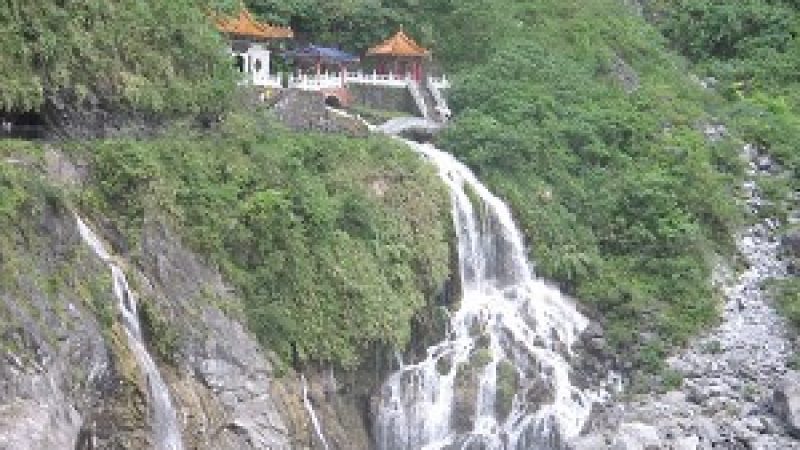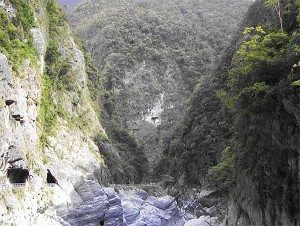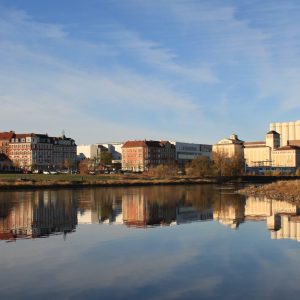
Taiwan’s Taroko National Park

Taiwan, the shape of a tobacco leaf, has a total area of 14,015 square miles. Two thirds of the area is covered by forested mountains. The remaining area consists of hilly country, plateaus, highlands, coastal plains, and basins. For tens of millions of years the constant movements of tectonic plates have given Taiwan a spectacular terrain. About 400 years ago, the Portuguese explorers fell in love with it and called it „Ilha Formosa“ (beautiful).
Today, the natural beauty of these many areas is still intact. As small as it is, Taiwan, which is situated between the Eurasian Continent and the Pacific Ocean, is rich in natural resources. In order to conserve these resources, the government has established six national parks. Each has spectacular scenery, unique wildlife, and authentic local culture that are rarely seen anywhere else in the world.
There are many reasons why people fall in love with Taiwan. Some do because of the great hospitality the Taiwanese offer to their visitors. A visitor is treated as a guest, and the Taiwanese love guests.
International Appeal
Taiwan has emerged as one of Asia’s economic miracles and was ranked as the 14th largest trading country in the world in the last three decades. Although Taiwan lost some of its textile and inexpensive production to China, it produces more than a quarter of the world’s desktop computers and half if its laptops. Hsinchu Science, based in Industrial Park in the city of Hsinchu, is considered to be as big as—if not bigger than—California’s Silicon Valley.
Taiwanese culture is steeped in Chinese culture. The predominant religions are Taoism, Buddhism, Confucianism and a small number of Christian practices. So there you will see traditional cultural values. On almost every corner, there is a temple where individuals, as a daily ritual, go to burn incense and make offerings to the deities to improve health, have a child, or pass an exam, just as they might go to a modern shopping mall to buy expensive jewelry or designer clothes.
This is what is appealing to the visitor—the blend of modern Western lifestyle with the vitality of a traditional value-based culture. This is the feeling I got when I first landed in Taipei, a feeling that you are in a safe, peaceful, and serene place full of friendly and helpful people.
 '/>TUNNELING THROUGH BEAUTY: There are many roads tunneled out of the marble mountains revealing ever more breathtaking vistas. (Nadia Ghattas/The Epoch Times)
'/>TUNNELING THROUGH BEAUTY: There are many roads tunneled out of the marble mountains revealing ever more breathtaking vistas. (Nadia Ghattas/The Epoch Times)

Rare Mountainous Beauty
Mountain ranges are spread across the island and comprise 65 percent of the terrain. The Central Mountain Range stretches along the entire island from north to south and is 167 miles long. Rivers are on both sides, with the Yushan Mountain on the western side with its main peak reaching almost 12,000 feet high, the highest in Northeast Asia. This range is the most isolated and unspoiled area where you will see high cliffs jutting from the Pacific Ocean on the one side, and fertile hillsides and valleys on the other side. It has more than 293 heavily forested mountains that are over 10,000 feet high.
The area is unique for its steep marble gorges seldom seen anywhere else in the world, with its most famous gorge, The Taroko Gorge—92,000 acres of the island’s Central Mountain Range—a part of the Taroko National Park in eastern Taiwan. As you drive or hike in this park you will be so impressed by the views of the deep marble canyons, rushing white water, and immense cliffs.
The Liwu River carved the Taroko Gorge out of tall marble mountains, and tectonic movements produced creases in the marble surfaces. The river forms V-shaped valleys and steep cliffs. In some areas, the stone walls of the valley are so close together that only a thin line of sunlight makes it to the canyon floor. Waterfalls cascade from the cliffs, and trees cling to the vertical surfaces. The scenes bring to mind traditional Chinese brush paintings.
From Taipei, you must take the Central Cross Highway, which runs along the gorge bottom, providing breathtaking views of the Pacific on one side and the mountains on the other. The highway gives way to roads carved into the cliffs. The roads disappear into tunnels, and emerge with even more amazing views of the gorge.
To commemorate those who died building the Central Cross Island Highway, The Eternal Spring Shrine was built there. The shrine is behind a cliff where white water flows down, and behind the shrine the stone „Heavenly Stairs“ takes you to Guanyin Cave and Changuang Temple.
 NATURAL BEAUTY: Meandering rivulets have formed beautiful scenery along the gorge bottom. (Nadia Ghattas/The Epoch Times)
NATURAL BEAUTY: Meandering rivulets have formed beautiful scenery along the gorge bottom. (Nadia Ghattas/The Epoch Times)As you climb further north towards the park’s main settlement of Tiansiang (Tianziang), the views become more dramatic. This town is set on the edge of the gorge and backed by the mountains. It has plenty of tourist facilities such as the Grand Formosa Hotel, a first class hotel with beautiful and comfortable accommodations and good restaurants and, of course, other accommodations such as guest houses.
A Walk Through Wonder
There are quite a few trails you can take through the park. Take steep steps carved into the mountain to Wenshan Hot Springs, a large heated natural pool surrounded by marble walls. Here you can enjoy both the hot spring water (125 degrees Fahrenheit) and the cold river water rushing over your body. It’s an excellent place to rejuvenate. Or you can climb across a pedestrian bridge to Siangde (Xiangde) temple located 100 yards west of Tiansian. This temple has a 36-foot statue of Bodhisattva Avalokitsevara’s image and elaborate prayer halls.
The Shakadang Trail, west of the entrance, goes through the Shakadang tunnel. The round trip takes about three to four hours walking time to 3D Cabin, a place for those who admire birds and butterflies.
One of the best trails in Taroko Gorge is the tunnel of Nine Turns Trail, about 1.2 miles long. Here you will enjoy the marble gorges, the rivers, the cliffs, tunnels and the ecosystem of vegetation growing amidst the rocky terrain.
For bird and butterfly lovers, you will find at least fifty species of butterflies and 144 species of birds, such as Swinhoe’s pheasant, the Formosan and blue magpie, and an endless variety of trees and flowers. There are also 34 species of animals found in the park, including the black bear, Formosan Macaque (rock monkey), serow (goat antelope), wild boar, and sambar deer, to name a few.
Do not be surprised if every time you visit Taiwan, you are delighted by something new. Because of the tectonic forces still pushing at the earth, it is estimated that the gorge moves up by five centimeters every year.
(The Epoch Times)





























vielen Dank, dass Sie unseren Kommentar-Bereich nutzen.
Bitte verzichten Sie auf Unterstellungen, Schimpfworte, aggressive Formulierungen und Werbe-Links. Solche Kommentare werden wir nicht veröffentlichen. Dies umfasst ebenso abschweifende Kommentare, die keinen konkreten Bezug zum jeweiligen Artikel haben. Viele Kommentare waren bisher schon anregend und auf die Themen bezogen. Wir bitten Sie um eine Qualität, die den Artikeln entspricht, so haben wir alle etwas davon.
Da wir die Verantwortung für jeden veröffentlichten Kommentar tragen, geben wir Kommentare erst nach einer Prüfung frei. Je nach Aufkommen kann es deswegen zu zeitlichen Verzögerungen kommen.
Ihre Epoch Times - Redaktion